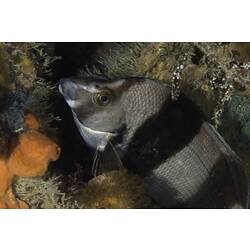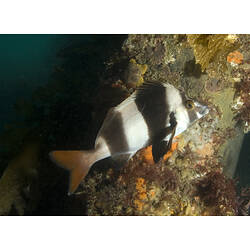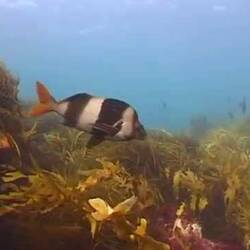General Description
Body compressed, moderately short and deep, dorsal profile of head concave, with short horns in front of eyes, thick lips, and lower rays of pectoral find elongate and thickened. Whitish with two broad dark bands encircling the body, black pelvic fins and a reddish-orange tail. Usually 20 cm long head to tail tip (up to 40 cm).
Biology
Relatively common on southern reefs, and individuals often form small groups on the deeper parts of estuaries and bays. Adults can rapidly change colour and the white space between the dark bands may become grey and the second dark band may appear white. While young Magpie Perch usually occur in sheltered bays in rocky and weedy areas or under piers and jetties, they are also seen in coastal rock pools.
Distribution
New Zealand and southern Australia.
Habitat
Shallow rocky reefs in coastal waters and estuaries.
More Information
-
Animal Type
-
Animal SubType
-
Brief Id
Body deep with two broad dark bands on sides, short horns in front of eyes, pectoral fins long with thickened lower rays.
-
Habitats
-
Diet
Carnivore
-
Diet Categories
Invertebrates, Worms
-
Endemicity
-
Commercial
No
-
Conservation Statuses
CITES: Not listed, FFG Threatened List: Not listed, EPBC Act 1999: Not listed, IUCN Red List: Least Concern
-
Depths
Shallow (1-30 m)
-
Water Column Locations
On or near seafloor
-
Taxon Name
-
Scientific Author
Richardson, 1850
-
Common Name
Magpie Perch
-
Kingdom
-
Phylum
-
Subphylum
-
Superclass
-
Class
-
Order
-
Family
-
Genus
-
Species Name
nigripes





